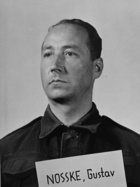Gustav Adolf Nosske
Gustav Nosske | |
|---|---|
 Gustav Nosske at the Einsatzgruppen Trial | |
| Born | 29 December 1902 Halle, German Empire |
| Died | 9 August 1986 (aged 83) Düsseldorf, West Germany |
| Allegiance | |
| Service/ | |
| Years of service | 1933–1945 |
| Rank | Obersturmbannführer |
| Unit | Einsatzgruppe D |
| Commands held | Einsatzkommando 12 |
| Other work | Lawyer |
Gustav Adolf Nosske (29 December 1902 – 9 August 1986) was a German lawyer and SS-Obersturmbannführer. In 1941–42, he commanded Einsatzkommando 12 within Einsatzgruppe D, under the command of Otto Ohlendorf. Tried in the Einsatzgruppen Trial in 1948, Nosske was sentenced to life imprisonment. He was released early in 1955.
Career[]
Gustav Aldolf Nosske was born on 29 December in Halle. After studying law, he became a lawyer in Halle and Aachen.[1] Nosske joined the Nazi Party and the SS in 1933. He became the head of the Gestapo in Aachen in 1935 and then in Frankfurt from September 1936 to June 1941.[2]
As a SS-Obersturmbannführer in rank, he was appointed chief of Einsatzkommando 12 before the invasion of the Soviet Union on 22 June 1941.[2][3] In the areas of Donetsk and Novocherkassk, his unit committed many atrocities against the civilian population. In mid-August 1941 Otto Ohlendorf ordered Nosske to transport 11,000 Jews from Mohyliv-Podilskyi to Yampil in order to make them cross the Dniester river and place them in the Romanian zone. During this walk hundreds of Jews were murdered.[4] Between 16 and 28 February 1942, Einsatzkommando 12 killed 721 Jews, 271 communists, 74 partisans and 421 Roma.
In April 1942 Nosske joined the Reich Security Main Office (RSHA) in Berlin concerning the Occupied Eastern Territories.[5] In 1943, he was appointed head of the "Foreigners and Enemies of the State" division of the Gestapo. He worked as a liaison officer between the Reich Ministry for the Occupied Eastern Territories and the RSHA. From August 1943 to September 1944 he was head of the state police in Düsseldorf. He did not execute the order to collect all German Jews of Düsseldorf married to non-Jews for extermination. The order was eventually not enforced.[6]
Trial and conviction[]
Nosske was arrested by the Allies and brought to trial at the Einsatzgruppen Trial in 1948 at Nuremberg. He was the only accused who did not seek clemency from General Lucius D. Clay in the American sector of occupation.[7] On 10 April 1948, Nosske was sentenced to life imprisonment for war crimes. He was released early, on 15 December 1951.[1]
His later life is unknown. On 26 March 1965, he testified as a witness at the Frankfurt Auschwitz Trials, with Düsseldorf as declared place of residence and legal advisor as profession.[8]
He likely died in 1990.[1]
References[]
- ^ a b c "Nosske Gustav Adolf %5BNazisme%A0%3A les Einsatzgruppen %282i%E8me guerre mondiale%29-%3ELes bourreaux. Biographies%5D". www.encyclopedie.bseditions.fr. Retrieved 2019-08-15.
- ^ a b Hesse, Klaus; Kufeke, Kay; Sander, Andreas (2010). Topography of Terror: Gestapo, SS and Reich Security Main Office on Wilhelm- and Prinz-Albrecht-Strasse : a Documentation. Stiftung Topographie des Terrors. p. 392. ISBN 9783941772076.
- ^ Tonder, Gerry van (2018-04-30). SS Einsatzgruppen: Nazi Death Squads, 1939–1945. Pen and Sword. ISBN 9781526729101.
- ^ Ralf Ogorreck. Les Einsatzgruppen ed. Calmann-Lévy 2007 p. 168 ISBN 978-2-286-03062-9
- ^ Tyas, Stephen (2017-06-25). SS-Major Horst Kopkow: From the Gestapo to British Intelligence. Fonthill Media.
- ^ Nathan Stoltzfus. Resistance of the Heart: Intermarriage and the Rosenstrasse Protest in Nazi Germany, Rutgers University Press, 2001, p. 256 ISBN 0-8135-2909-3
- ^ Richard Rhodes (2002). Masters of Death: The SS-Einsatzgruppen and the Invention of the Holocaust. New York: Alfred A. Knopf. p. 275. ISBN 0-375-40900-9.
- ^ Der 1. Frankfurter Auschwitz-Prozess (pdf)
- 1902 births
- 1990 deaths
- People from Halle (Saale)
- Lawyers in the Nazi Party
- SS-Obersturmbannführer
- Gestapo personnel
- Einsatzgruppen personnel
- Holocaust perpetrators in Russia
- People convicted by the United States Nuremberg Military Tribunals
- Holocaust perpetrators in Ukraine
- Military personnel from Düsseldorf
- Reich Security Main Office personnel
- 20th-century German lawyers
- Jurists from North Rhine-Westphalia